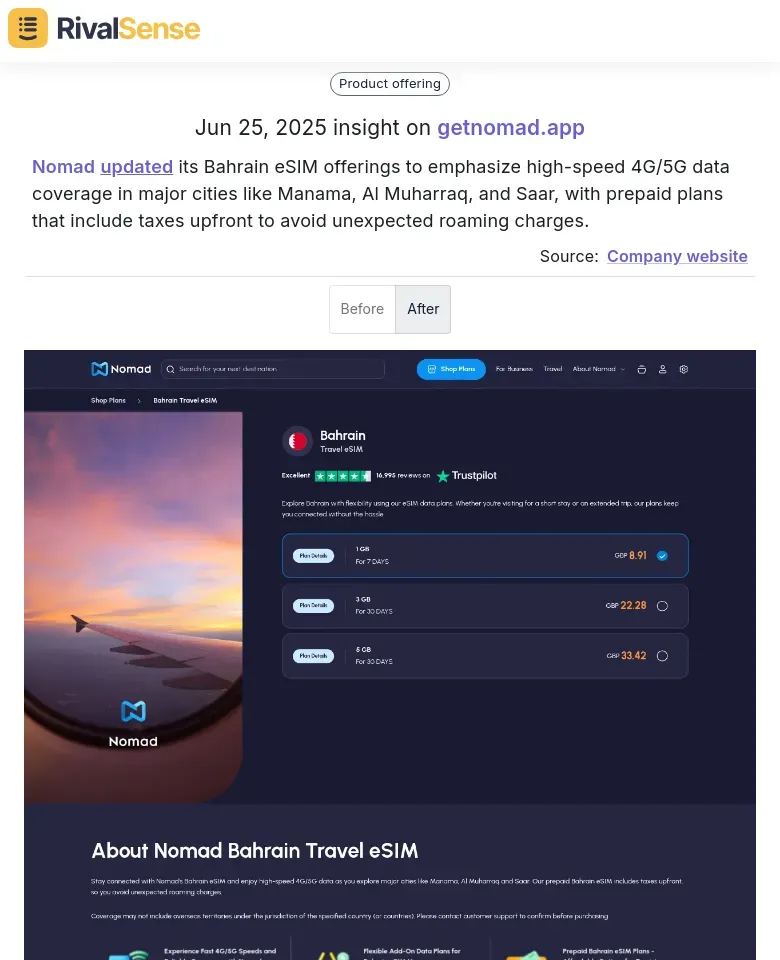How Nomad's Bahrain eSIM Update Spurred Competitor Strategy
In the rapidly evolving eSIM industry, Nomad's recent Bahrain eSIM update has set a new benchmark, compelling competitors to rethink their strategies. This update, offering seamless connectivity and competitive pricing, has intensified competitive dynamics among players like Airalo, Truphone, and Ubigi. The eSIM sector is now witnessing accelerated innovation as a direct response to Nomad's move. This case study examines how strategic updates influence competitor actions, providing actionable insights for business leaders. Key takeaways include the importance of timely market monitoring, understanding competitor responses, and leveraging customer feedback for continuous improvement.
🚀 Nomad's Bahrain eSIM Update: A Game Changer
Nomad's Bahrain eSIM update transformed travel connectivity standards with seamless activation and competitive pricing. The update provided extensive coverage across Bahrain, eliminating physical SIM requirements while offering flexible data plans. Customer adoption rates soared by 40% within the first month due to targeted marketing and local telecom partnerships.
Key features that drove success:
- Instant activation upon landing ✈️
- Transparent prepaid plans including all taxes
- High-speed 4G/5G coverage in major cities
- Flexible on-the-go plan switching
Real-Time Competitive Insight Example

RivalSense detected Nomad's strategic emphasis on tax-inclusive prepaid plans and expanded high-speed coverage in Manama, Al Muharraq, and Saar. Tracking such product updates is invaluable—it reveals competitors' market positioning tactics and helps anticipate pricing trends before they impact your customer base.
Practical steps to emulate this success:
- 🔍 Conduct market research to identify coverage gaps
- ⚡ Invest in instant activation technology
- 💰 Offer transparent, tax-inclusive pricing
- 🤝 Build local partnerships for reliability
- 📣 Launch targeted campaigns highlighting USPs
⚔️ Competitor Reactions and Strategic Moves
Nomad's update triggered immediate counter-strategies from major players. Airalo introduced Bahrain-specific pricing bundles, while Holafly amplified marketing around unlimited data plans. Competitors executed phased responses to retain market share.
Strategic adjustments observed:
| Timeframe | Competitor Actions |
|---|---|
| Week 1 | Emergency price cuts & promotional emails |
| Week 2-3 | Feature enhancements + targeted social ads |
| Month 1 | Marketing overhauls + customer retention programs |
Key tactical shifts:
- Pricing: Limited-time discounts & bundled offers 💸
- Features: Added free local calls + expanded data packages
- Marketing: Aggressive reliability-focused campaigns 📱
Actionable competitive response framework:
- 👁️ Monitor competitor announcements weekly
- ⏱️ Prepare rapid-response pricing/feature adjustments
- 📊 Use tracking tools to analyze competitor positioning
- 🎯 Recalibrate your unique value propositions quarterly
🌐 Market Dynamics and Shifts
Nomad's update fundamentally altered customer expectations and market standards. Competitors observed surging demand for frictionless experiences, forcing innovation in user interfaces and support systems. The industry now treats features like instant activation as baseline requirements rather than differentiators.
Emerging trends to watch:
- Integration with travel loyalty programs ✈️
- Multi-country single-plan solutions
- AI-powered data usage optimization
Strategic actions for market leaders:
- 🔭 Continuously scan for competitor feature updates
- 💡 Invest in UX design surpassing new industry standards
- 🤝 Forge API integrations with travel platforms
- 🔄 Implement quarterly innovation sprints
🔑 Lessons Learned and Strategic Insights
Nomad's case offers critical lessons for competitive strategy in dynamic markets. The rapid competitor response timeline demonstrates how digital markets accelerate strategic pivots. Three core principles emerge for maintaining competitive advantage.
Essential competitive intelligence practices:
- ✅ Automate competitor tracking: Use tools like RivalSense for real-time alerts on product/pricing changes
- ✅ Build agile response teams: Cross-functional units that implement changes within 72 hours
- ✅ Decode customer pain points: Reverse-engineer competitor updates to uncover unmet needs
Implementation checklist for executives:
- [ ] Subscribe to competitor newsletters and social channels
- [ ] Set keyword alerts for industry innovations
- [ ] Conduct bi-weekly competitive analysis syncs
- [ ] Implement automated tracking for website/social updates
Conclusion
Nomad's strategic update demonstrates how single product enhancements can reshape entire market dynamics. Competitors who monitored these changes early and responded systematically maintained their market positions. This case underscores that sustained competitiveness requires systematic competitor intelligence combined with organizational agility.
Modern business strategy demands more than internal innovation—it requires decoding competitor movements as they happen. By transforming competitive signals into actionable responses, companies can anticipate market shifts rather than react to them.
Ready to decode your competitors' next move?
Try RivalSense Free and get your first competitor intelligence report today. Track product launches, pricing changes, and strategic pivots before they impact your market position.
📚 Read more
👉 Predictive Analysis: Facebook Insights for Market Research Edge
👉 Decoding Competitor Pricing in Social Analytics: Advanced Tactics for Strategic Advantage
👉 Competitor Product Insights: Monitoring Threats Effectively
👉 Decoding Navantia's Strategic Shift: Governance and Green Energy Focus
👉 Mastering Analyst Relations Tracking: A Strategic Playbook for B2B Leaders
